Paraphrasing vs Plagiarism – What is the Difference?
People usually confuse paraphrasing with plagiarism, but the fact is that both of these terms are different. If you are confused about the concept of paraphrasing and plagiarism, read this article carefully. In this article, we will tell you all about what plagiarism and paraphrasing are and the key difference between plagiarism and paraphrasing. So, let’s get started!
What is Plagiarism?
The most common definition of plagiarism is copying or borrowing ideas or words belonging to another writer. We would also define plagiarism as, stealing and presenting’ content as you own, which originally belongs to another writer/author. Here you must know that whenever you are using ideas or words of another writer without crediting their source, it will result in plagiarism.
In other words, plagiarism is literary theft and is considered an act of fraud all across the globe. Now that you know what plagiarism is, you must also know about the things that are considered plagiarism.
- Stealing and using ideas of another author without credits is also a form of plagiarism
- Not using quotation marks where needed would also result in duplication
- Giving wrong information in citations is also a serious offense and considered plagiarism
- Spinning original words with synonyms or tweaking the voice of content is also considered plagiarism
- Copying content from different sources and creating new content also comes under plagiarism
Today there are different types of plagiarism that you have to beware of. These include:
- Complete plagiarism, in which each word of your post is copied.
- Direct plagiarism is presenting another writer’s work as your own.
- Self-plagiarism is duplicating or using your own words or ideas.
- Accidental plagiarism is when your words accidentally match that of another writer.
- Mosaic plagiarism collects duplicate words/sentences from more than one source.

What is Paraphrasing?
Paraphrasing in simple words, presenting information or ideas that belong to another writer in your own words. When you use your own words and writing style to demonstrate content you have read, it would be defined as paraphrasing. You should know that paraphrasing is also known as rewriting.
Now that you know what paraphrasing is, it is also important to know the top five steps involved in paraphrasing.
- Read the original text multiple times to understand its core message.
- Take a notepad and write down all the important points and concepts you have read in the article.
- Now start writing your version without taking help from the original resource. You can take help and references from your notes.
- After writing the content, you have to compare it with the original version so that there are no similarities. Edit and make changes if you find similarities in content.
- Add citations to the sources at the end of the article.
What is the Core Difference between Plagiarism and Paraphrasing?
After reading the above two sections, you would be thinking that paraphrasing content is the same as committing plagiarism. This is not true because plagiarism refers to using the same ideas or words produced by another writer and presenting them as your own. While paraphrasing is presenting someone else’s ideas in your own words while crediting the original author for their ideas. You need to know that if you are not citing the original source when paraphrasing, it will result in a plagiarism accusation. Moreover, having similarities with the original text can also result in plagiarism.
Read more: Difference between Columns and Rows
What are the similarities between Plagiarism and Paraphrasing?
Plagiarism and paraphrasing are both commonly used in written communication. Although plagiarism is often considered to be a form of paraphrasing, the two differ in how accurately they represent the ideas of other people.
Because paraphrasing involves a more accurate representation of information, it is usually considered to be more ethical than plagiarism. However, some types of paraphrasing can also be considered to be unethical.
When paraphrasing, you need to make sure that you are not simply changing a few words so that the sentences look different but still retain the same meaning. Paraphrasing incorrectly can often result in plagiarism.
An example would be as follows: Original source: The results were compared to those obtained in previous studies; however, no significant differences were observed (Smith, 2010). Poor paraphrase: The results were compared to those found in previous studies with similar findings (Smith 2010). Correct paraphrase: Research findings from this study were similar to those found in earlier studies conducted by other researchers (Smith 2010).
Read more: 5 Steps To Quality Essay Writing with Examples
When does Paraphrasing or Rewriting Count as Duplication?
Here are some of the instances when paraphrased content would be accused of plagiarism:
- You will be accused of plagiarism if you don’t add references to the source.
- If your text is close to the original wording, it will also result in plagiarism.
- Not adding quotation marks to the words that are not yours.
How Can You Find out if Your Paraphrased Content has Plagiarism in It?
While creating content, there is always a chance that your rewritten text can be accused of plagiarism. If you don’t want this to happen, you should use an online free plagiarism checker. A plagiarism tool can scan your content and highlight similarities in a few seconds. The utility also provides a report which includes the percentage of duplication and original content and links to the matched sources. Using the report, you can remove the duplicate content highlighted by the utility and cite the reference links.



